 W
WKabbalah is an esoteric method, discipline, and school of thought in Jewish mysticism. A traditional Kabbalist in Judaism is called a Mequbbāl. The definition of Kabbalah varies according to the tradition and aims of those following it, from its religious origin as an integral part of Judaism, to its later adaptations in Western esotericism. Jewish Kabbalah is a set of esoteric teachings meant to explain the relationship between the unchanging, eternal God—the mysterious Ein Sof —and the mortal, finite universe. It forms the foundation of mystical religious interpretations within Judaism.
 W
WAncient of Days is a name for God in the Book of Daniel.
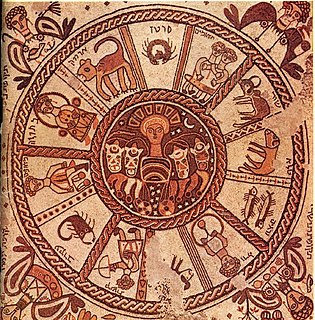 W
WAstrology has been a topic of debate among Jews for over 2000 years. While not a Jewish practice or teaching as such, astrology made its way into Jewish thought, as can be seen in the many references to it in the Talmud. Astrological statements became accepted and worthy of debate and discussion by Torah scholars. Opinions varied: some rabbis rejected the validity of astrology; others accepted its validity but forbid practicing it; still others thought its practice to be meaningful and permitted. In modern times, as science has rejected the validity of astrology, many Jewish thinkers have similarly rejected it; though some continue to defend the pro-astrology views that were common among pre-modern Jews.
 W
WA Baal Shem was a historical Jewish practitioner of Practical Kabbalah and supposed miracle worker. Employing the names of God, angels, Satan and other spirits, Baal Shem are claimed to heal, enact miracles, perform exorcisms, treat various health issues, curb epidemics, protect people from disaster due to fire, robbery or the evil eye, foresee the future, decipher dreams, and bless those who sought his powers.
 W
WBarachiel is one of the seven Archangels in Byzantine Catholic and Eastern Orthodox tradition. He is the Archangel of Lightning and Blessings.
 W
WBnei Baruch is a universalist kabbalah association founded by Michael Laitman in the early 1990s. It is estimated to have around 50,000 students in Israel, and some 150,000 around the world.
 W
WChabad, also known as Lubavitch, Habad and Chabad-Lubavitch, is an Orthodox Jewish Hasidic dynasty. Chabad is one of the world's best-known Hasidic movements, particularly for its outreach activities. It is one of the largest Hasidic groups and Jewish religious organizations in the world. Unlike most ultra-Orthodox groups, which are self-segregating, Chabad operates mainly in the wider world and caters to secularized Jews.
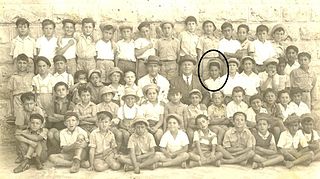 W
WJoseph Dan is an Israeli scholar of Jewish mysticism. He taught for over 40 years in the Department of Jewish Thought at the Hebrew University of Jerusalem. He was the first incumbent of the Gershom Scholem Chair in Jewish Mysticism at The Hebrew University.
 W
WRachel Elior is an Israeli professor of Jewish philosophy at the Hebrew University of Jerusalem in Jerusalem, Israel. Her principal subjects of research has been Hasidism and the history of early Jewish mysticism.
 W
WThe Four Worlds, sometimes counted with a prior stage to make Five Worlds, are the comprehensive categories of spiritual realms in Kabbalah in the descending chain of Existence. The concept of "Worlds" denotes the emanation of creative lifeforce from the Ein Sof Divine Infinite, through progressive, innumerable tzimtzumim (concealments/veilings/condensations). As particular sefirot dominate in each realm, so the primordial fifth World, Adam Kadmon, is often excluded for its transcendence, and the four subsequent Worlds are usually referred to. Their names are read out from Isaiah 43:7, "Every one that is called by My name and for My glory, I have created, I have formed, even I have made" each elucidating the names Atziluth ("Emanation/Close"), Beriah ("Creation"), Yetzirah ("Formation"), and Asiyah ("Action"). Below Asiyah, the lowest spiritual World, is Asiyah-Gashmi, our Physical Universe, which enclothes its last two sefirot “emanations”. Collectively, the Four Worlds are also referred to as ABiYA, after their initial letters. As well as the functional role each World has in the process of Creation, they also embody dimensions of consciousness within human experience.
 W
WThe Golem and the Jinni is a debut novel written by Helene Wecker, published by Harper in April 2013. It combines the genre of historical fiction with elements of fantasy, telling the story of two displaced magical creatures in 19th century New York City. A sequel, The Hidden Palace, was published in June 2021.
 W
WHermetic Qabalah is a Western esoteric tradition involving mysticism and the occult. It is the underlying philosophy and framework for magical societies such as the Golden Dawn, Thelemic orders, mystical-religious societies such as the Builders of the Adytum and the Fellowship of the Rosy Cross, and is a precursor to the Neopagan, Wiccan and New Age movements. The Hermetic Qabalah is the basis for Qliphothic Qabala as studied by left hand path orders, such as the Typhonian Order.
 W
WBaron Emmanuel van der Linden d'Hooghvorst (1914–1999), was a Belgian writer, spagyric philosopher and alchemist.
 W
WBoaz Huss is a professor of Kabbalah at the Goldstein-Goren Department of Jewish Thought at Ben-Gurion University of the Negev. He is a leading scholar in contemporary Kabbalah.
 W
WMoshe Idel is a Romanian-Israeli historian and philosopher of Jewish mysticism. He is Emeritus Max Cooper Professor in Jewish Thought at the Hebrew University, Jerusalem, and a Senior Researcher at the Shalom Hartman Institute.
 W
WJewish meditation includes practices of settling the mind, introspection, visualization, emotional insight, contemplation of divine names, or concentration on philosophical, ethical or mystical ideas. Meditation may accompany unstructured, personal Jewish prayer, may be part of structured Jewish services, or may be separate from prayer practices. Jewish mystics have viewed meditation as leading to devekut. Hebrew terms for meditation include hitbodedut or hitbonenut/hisbonenus ("contemplation").
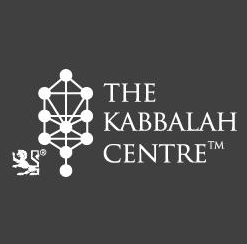 W
WThe Kabbalah Centre International is a non-profit organization located in Los Angeles, California that provides courses on the Zohar and Kabbalistic teachings online as well as through its regional and city-based centers and study groups worldwide. The Kabbalah Centre's presentation of Kabbalah was developed by its director, Philip Berg, along with his wife, Karen Berg.
 W
WThe concepts and structures of Jewish Kabbalah have been used in the contemporary world to open comparative dialogue and cross-fertilization with modern secular disciplines in the Sciences and Humanities. This has been an uncommon phenomenon, since it requires wide internal understanding of both traditionalist Kabbalah and modern secular thought, and for social reasons Jewish modernity has seen isolation and entrenchment between the two. Skilled authorities in both traditions have included contemporary traditionalist Orthodox teachers of Kabbalah, as well as Neo-Kabbalistic and Academic scholars who read Kabbalah in a critical, universalist way.
 W
WYehuda Liebes is an Israeli academic and scholar. He is the Gershom Scholem Professor Emeritus of Kabbalah at the Hebrew University of Jerusalem. He is considered a leading scholar of Kabbalah; his other research interests include Jewish myth, Sabbateanism, and the links between Judaism and ancient Greek religion, Christianity, and Islam. He is the recipient of the 1997 Bialik Prize, the 1999 Gershom Scholem Prize for Kabbalah Research, the 2006 EMET Prize for Art, Science and Culture, and the 2017 Israel Prize.
 W
WLilith is a demonic figure in Judaic mythology, supposedly the primordial she-demon and alternatively first wife of Adam. She is presumed to be mentioned in Biblical Hebrew in the Book of Isaiah, and later in Late Antiquity in Mandaean Gnosticism mythology and Jewish mythology sources from 500 CE onwards. Lilith appears in historiolas in various concepts and localities that give partial descriptions of her. She is mentioned in the Babylonian Talmud, in the Book of Adam and Eve as Adam's first wife, and in the Zohar Leviticus 19a as "a hot fiery female who first cohabited with man".
 W
WThe Manna Machine is a 1978 book by George Sassoon and Rodney Dale, based upon a translation of the section of the Zohar called The Ancient of Days that concludes that a machine had created algae as food for human beings in biblical times.
 W
W"Pardes" refers to approaches to biblical exegesis in rabbinic Judaism or to interpretation of text in Torah study. The term, sometimes also rendered PaRDeS, is an acronym formed from the initials of the following four approaches:Peshat – "surface" ("straight") or the literal (direct) meaning. Remez – "hints" or the deep meaning beyond just the literal sense. Derash – from Hebrew darash: "inquire" ("seek") – the comparative (midrashic) meaning, as given through similar occurrences. Sod – "secret" ("mystery") or the esoteric/mystical meaning, as given through inspiration or revelation.
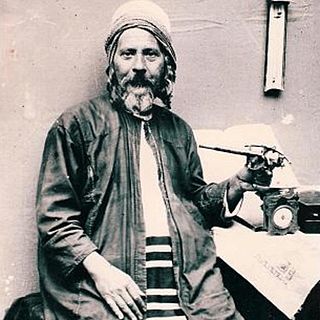 W
WYiḥyah Qafiḥ (1850–1931), known also by his term of endearment "Ha-Yashish", served as the Chief Rabbi of Sana'a, Yemen in the late nineteenth and early twentieth centuries. He was one of the foremost rabbinical scholars in Sana'a during that period, and one who advocated many reforms in Jewish education. Besides being learned in astronomy and in the metaphysical science of rabbinic astrology, as well as in Jewish classical literature which he taught to his young students.
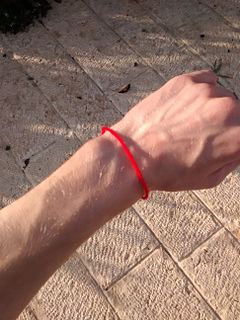 W
WWearing a thin scarlet or crimson string as a type of talisman is a Jewish folk custom as a way to ward off misfortune brought about by the "evil eye". The tradition is popularly thought to be associated with Kabbalah and religious forms of Judaism.
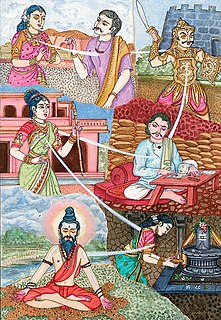 W
WReincarnation, also known as rebirth or transmigration, is the philosophical or religious concept that the non-physical essence of a living being begins a new life in a different physical form or body after biological death. Resurrection is a similar process hypothesized by some religions, in which a soul comes back to life in the same body. In most beliefs involving reincarnation, the soul is seen as immortal and the only thing that becomes perishable is the body. Upon death, the soul becomes transmigrated into a new infant to live again. The term transmigration means passing of soul from one body to another after-death.
 W
WGershom Scholem, was a German-born Israeli philosopher and historian. He is widely regarded as the founder of the modern, academic study of Kabbalah. He was the first professor of Jewish Mysticism at Hebrew University of Jerusalem. His close friends included Theodore Adorno, Hannah Arendt, Walter Benjamin and Leo Strauss, and selected letters from his correspondence with those philosophers have been published. He was also friendly with the author Shai Agnon and the Talmudic scholar Saul Lieberman.
 W
WSefirot, meaning emanations, are the 10 attributes/emanations in Kabbalah, through which Ein Sof reveals himself and continuously creates both the physical realm and the chain of higher metaphysical realms. The term is alternatively transliterated into English as sephirot/sephiroth, singular sefirah/sephirah etc.
 W
WShaar Hashamayim Yeshiva is an Ashkenazi yeshiva in Jerusalem dedicated to the study of the kabbalistic teachings of the Arizal. It is famous for its student body of advanced kabbalists — many of them roshei yeshiva and Torah scholars — as well as beginning and intermediate scholars who study both the revealed and concealed Torah.
 W
WThe tetractys, or tetrad, or the tetractys of the decad is a triangular figure consisting of ten points arranged in four rows: one, two, three, and four points in each row, which is the geometrical representation of the fourth triangular number. As a mystical symbol, it was very important to the secret worship of Pythagoreanism. There were four seasons, and the number was also associated with planetary motions and music.
 W
WThe Tree of Immortality is the tree of life motif as it appears in the Quran. It is also alluded to in hadiths and tafsir. Unlike the biblical account, the Quran mentions only one tree in Eden, also called the tree of immortality, which Allah specifically forbade to Adam and Eve; in other words, there is no tree of knowledge in the Quran. The tree in the Quran is used as an example for a concept, idea, way of life or code of life. A good concept/idea is represented as a good tree and a bad idea/concept is represented as a bad tree. Satan appeared to them and told them that the only reason God forbade them to eat from that tree is that they would become angels (malak) or start using the idea/concept of ownerships (mulk) in conjunction with inheritance generations after generations which Iblis convinced Adam to accept.
 W
WTzadik is a title in Judaism given to people considered righteous, such as biblical figures and later spiritual masters. The root of the word ṣadiq, is ṣ-d-q, which means "justice" or "righteousness". When applied to a righteous woman, the term is inflected as tzadeikes/tzaddeket.
 W
WYesod is a sephirah or node in the kabbalistic Tree of Life, a system of Jewish philosophy. Yesod, located near the base of the Tree, is the sephirah below Hod and Netzach, and above Malkuth. It is seen as a vehicle allowing movement from one thing or condition to another. Yesod, Kabbalah, and the Tree of Life are Jewish concepts adopted by various philosophical systems including Christianity, New Age Eastern-based mysticism, and Western esoteric practices.
 W
WA Yom Hillula is another word for yahrzeit. However, it differs from a regular yahrzeit in two respects. It refers specifically to the yahrzeit of a great Tzaddik who taught Kabbalah and/or Chassidus, and unlike a regular yahrzeit, which is marked with sadness and even fasting, a Yom Hillula is commemorated specifically through simcha (joy), and festive celebration. This term is most often used in Hasidic circles to refer to the day of the death of Hasidic Rebbes. According to Kabbalah, on the Yartzheit of a Tzaddik, all the spiritual redemption of their life shines into this World, contributing to the Messianic redemption and bringing spiritual blessing to all who are connected to them. The supreme Tzadik of the generation is described as the all-inclusive, general soul of the Jewish people, further emphasised in Hasidic doctrine. The observation of a hillula in North African Jewish communities is also widespread, especially in Morocco, with the Hiloula of Rabbi Isaac Ben Walid and the Hiloula of Rabbi Amram ben Diwan <--(the Yom Hillula of Rabbi Amram ben Diwan) among them, as well as the Baba Sali in the Israeli town of Netivot.